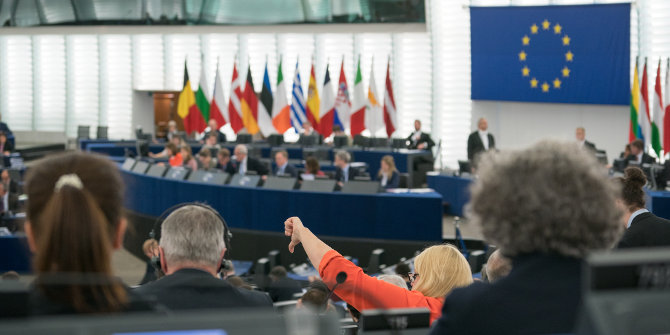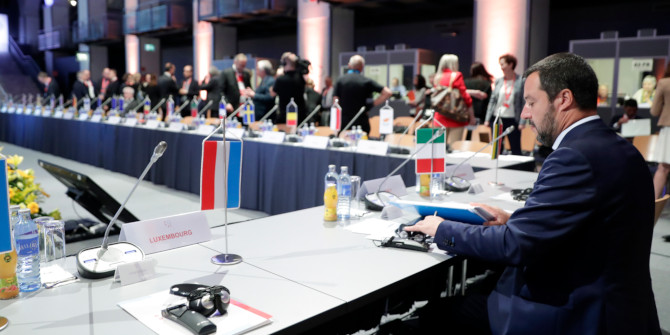The Swedish general election held on 11 September produced a small majority for the opposition right bloc. Jonathan Polk assesses what the results mean for Swedish politics.
The Social Democratic Party received the most votes in the Swedish parliamentary election held on 11 September 2022. The party, in government since 2014, even increased its vote share to 30.3%, up two percentage points from the previous election in 2018.
Yet the focus of attention in Sweden has been on the continued rise of the anti-immigration Sweden Democrats, a far-right party that has expanded its vote share from 5.7% in 2010, the year of its electoral breakthrough at the national level, to 20.5% in 2022. In just over a decade and only four electoral cycles since first entering parliament, the Sweden Democrats have gone from a marginal, ostracised party to the second largest party in Sweden and the largest party of the right bloc. But it is the centre-right Moderates, now the third largest party, that will in all likelihood get the first chance to form a government.
Winners and losers
Despite her party receiving the most votes, Magdalena Andersson, the leader of the Social Democrats, announced on Wednesday night that she will step down as prime minister today. There are eight political parties currently in Sweden’s legislature, the Riksdag, and the same eight parties crossed the electoral threshold for representation in the next legislative term.
Of these eight parties, four supported Andersson for prime minister: the Social Democrats (S), the Centre Party (C), the Left Party (V), and the Greens (MP). The 349 seats in the Riksdag, require 175 for a majority, and although the initial exit poll indicated a slim majority for this red-green bloc, as vote counting continued the results swung to a bare majority for the opposition right bloc.
While the vote shares of the Social Democrats and the Greens increased, both the Centre Party and the Left Party lost sufficient support compared to 2018 to deprive the left bloc of a majority. There is a large gap between the Centre Party and the Left Party on economic policies, producing ideological strain for both parties. The Social Democrats’ location between the Centre Party and the Left Party on the economic left-right dimension likely complicated campaign message clarity for all three parties on these topics.
The largest party of the right bloc up until this year was the Moderates (M), led by Ulf Kristersson. Alongside the Moderates, the right bloc also contains the Sweden Democrats (SD), Christian Democrats (KD), and Liberals (L). With 99% of the votes counted, this four-party opposition bloc has 176 seats, just one more than the amount necessary to support a change in government.
A gap of just 50,000 votes separated the two blocs on election night. This was fewer than the 97,724 votes going to parties that did not reach the electoral threshold, and fewer also than the 92,000 people currently waiting for decisions on citizenship applications from the migration agency.
Campaign issues
The campaign was contested on ground favourable to the Sweden Democrats, with a focus on violent crime, issues of law and order, and the challenges of social segregation. Given a campaign surrounding topics emphasised by the political right, high levels of inflation and electricity prices, and two terms in government, it is all the more remarkable that the Social Democrats received more votes in 2022 than they had in 2018.
Both the Moderates and even the Social Democrats stressed the need to “get tough” on crime and generally embraced more conservative positions on questions related to law and order and immigrant integration. This did little to stem the rise of the Sweden Democrats. The exit polls indicate that both the Social Democrats and the Moderates lost voters to the Sweden Democrats, with the Sweden Democrats passing the Moderates to become the second largest party in the country. This latter fact increases the complexity of negotiations to form a right-wing government.
Government formation
Kristersson and the Moderates are set to receive the first opportunity to form a government even though the party received fewer votes than the Sweden Democrats. This is because of the lingering ambivalence of the other Swedish parliamentary parties towards the extremist roots of the Sweden Democrats, a party with a fascist and white nationalist history.
Prior to the election, the Moderates, Christian Democrats, and Liberals all indicated that while they were now ready to rely on support from the Sweden Democrats to form a minority government, they were unwilling to formally bring the party into government and allocate it ministerial portfolios. It remains to be seen if the parties will continue to hold this line after the Sweden Democrats’ strong showing at the ballot box, but it highlights the reluctance of the other parties to support the party’s leader, Jimmie Åkesson, as prime minister.
If, however, the Sweden Democrats are relegated to the role of a support party for a minority right-wing government headed by Kristersson, the policy concessions demanded by Åkesson will be considerable, given the Sweden Democrats’ electoral strength. But such concessions would in turn generate strain within the right bloc, particularly for Liberals, the smallest parliamentary party, which just cleared the 4% threshold for representation in the Riksdag.
When the former four-party right bloc of Swedish parties, called the Alliance, broke apart in early 2019, disagreements about collaboration with the Sweden Democrats were at the root of the split. While the Christian Democrats and Moderates rather quickly endorsed working with the Sweden Democrats to form a right-wing government ahead of 2022, the Liberals and Centre Party did not.
The Liberals spent much of the last three years in existential deliberation about the direction of the party, frequently falling below 4% in the opinion polls, before finally deciding to join the Moderates and Christian Democrats in campaigning for a right-wing government with the support of the Sweden Democrats. This decision split the party and with only a one or two seat margin, Kristersson would have little if any room for dissent in such a governing coalition. While the government formation process may not take the 134 days it did following the 2018 election, an unusually long time in Sweden, it will likely still be complex and difficult this time around.
What next?
Important actors to watch in the next legislative term include politicians from the Liberals, Centre Party, and Sweden Democrats. As mentioned, the Liberals remain internally divided on collaboration with the Sweden Democrats and one or two Liberal members of parliament could make the difference between legislative success or failure for a right-wing government. That said, the party barely crossed the 4% threshold and it is unlikely to be eager for early elections to be called, which could hold back any voices of dissent within the party for the time being.
Unlike the Liberals, who broke to the right, the Centre Party, also a former member of the Alliance, chose the opposite direction, categorically refusing to work with the Sweden Democrats and instead supporting an Andersson-led Social Democrat government. The Centre Party’s 6.7% of the vote in 2022 represents a decline of nearly two percentage points and the association with the red-green bloc generated tension within the party’s right-wing.
It remains to be seen if the underwhelming showing at the polls in 2022 will empower voices calling for a different direction for the Centre Party. One complicating factor is the party’s long journey to becoming a solidly socio-culturally liberal party over the past twenty years, making any collaboration with the Sweden Democrats quite a challenge (though a challenge the Liberals appear to have embraced).
Finally, the behaviour of individual Sweden Democrat members of parliament could have considerable consequences. In an attempt to detoxify the party, Åkesson and the Sweden Democrats have expelled party members for overt extremism and racism in the past. With its largest parliamentary delegation yet, it will be important to see if the party and its individual members of parliament are able to avoid scandals or other actions that could jeopardise its capacity to implement preferred policies.
The Social Democratic minority governments that followed the 2018 election were weak, strained by large ideological differences between support parties. With what is currently a two-seat margin for error and a stridently anti-establishment, nativist party as the largest parliamentary force in any right-wing bloc, the new government could face an equally tenuous arrangement.
Alternatively, we may see a further consolidation of the right-nationalist tone of the 2022 campaign in the ideology and policymaking of the incoming government. These developments will have additional consequences for Europe given Sweden takes over the presidency of the Council of the European Union in January 2023.
A version of this article originally appeared at whogoverns.eu
Note: This article gives the views of the author, not the position of EUROPP – European Politics and Policy or the London School of Economics. Featured image credit: European Council






I want a re-election. Had I known that the Liberals will support a Sweden Democratic lead government I would have voted for the Social Democrats.
The Socialists have established a monopoly on all the Swedish institutions for the last 100 years. Now it is broken. The left mendacious cliché of the right wing parties having nazi roots do not catch anymore, anywhere in Europe.
The Left proved to be a failure. Everywhere.
The left always based their communication on propaganda. It was the radical left that started propaganda and the national socialists in Germany copied it, not the other way around. In fact the National Socialists and Fascists in Italy had both Marxist/revolutionary/socialist roots (and implementation). It was propaganda that created the false ideological dichotomy of right-left. They were both statist/socialists with one being focused on ultranationalism whereas the others on taking orders from Moscow that the former wouldn’t tolerate. Not much difference between the two ideologies. Both were/are anti-capitalist socialist and statist.
What do you think is more likely here – M + KD or M + KD + L?